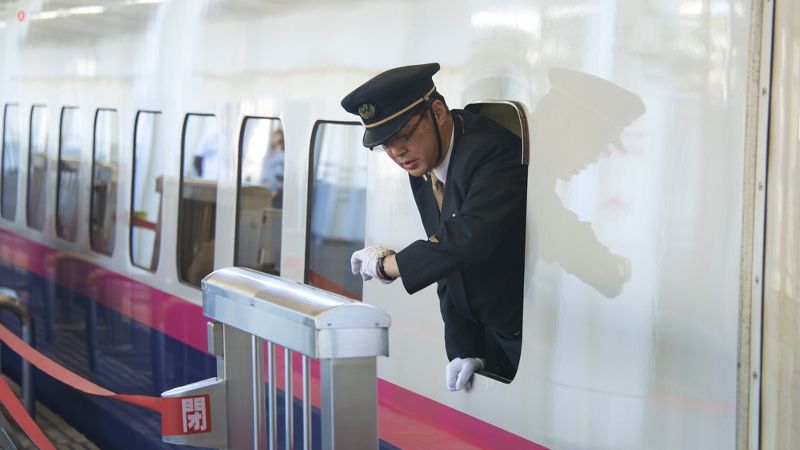Although the public transportation network is incredibly efficient and Japanese trains are a great way to get around the whole the country, foreign visitors to Japan may at first have some difficulty navigating timetables and deciding which trains they need to catch.
Furthermore, while many railway, bus and ferry schedules may be published online on the website of the operators, it may often be difficult to find English-language versions.
However, although some printed Japanese train timetables may be hard to understand, there are a number of useful online tools that travelers on Shinkansen trains with the JR Pass are able to use to organise their schedule, including the Hyperdia timetable app.
Below you’ll find a complete guide to how to find train schedules online, as well as how to read Japanese train timetables if the need arises.
Table of Contents
Check timetables with Hyperdia
The most popular online service for finding Shinkansen train timetables online among foreign tourists is Hyperdia, an online tool available on the web and also in apps for Android and iOS, largely thanks to its flexible search options and availability in English.
The best part of Hyperdia is that the basic search functions allows users to quickly find a route between two Shinkansen stations.
How to find a route on Hyperdia
In order to find a route with a Hyperdia search, you simply need to enter the name of the place of departure in the ‘From’ field, and the destination in the ‘To’ field. Hyperdia will attempt to autocomplete the station name after you have inputted a few letters.
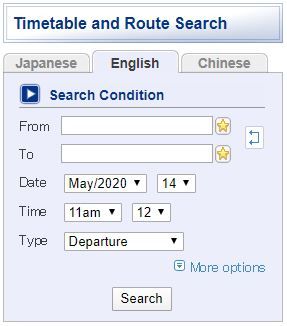
Applicants should also select the travel dates. As Shinkansen timetables are only published a few months in advance, those who wish to find results for a trip more than 2-3 months in the future are advised to input a similar date) in the near future instead.
It is then necessary to select a time and whether it is intended for departure or arrival. Travelers who wish to search for the first connection of the day should select a departure time around 3am, while an arrival time of 3am should be selected for those searching for the last connection of the day.
Finally, by clicking on the ‘Search Details’ button, applicants can open the advanced search option where they can further refine the details of their desired trip.
Hyperdia advanced search option
The advanced search option on Hyperdia is a great resource for JR Pass holders, as it allows certain train types to be excluded from the results.
To optimize the results, travelers can input the stations which they want to include on the route, by entering the names in the Pass 1-3 boxes. They can also select the order they wish the results to be displayed (.e.g by time), and the number of options shown.
By checking ‘Airplane’ and ‘Airport Shuttle Bus’, travelers are able to include flights and transport from an airport in the results, and by checking ‘Bullet Train’, they are able to include all Shinkansen.
Underneath, there is a list of different types of Japanese trains which can be checked to include these options in the search results, including trains not covered by the JR Pass and the limited express trains, which require a surcharge.
Understanding Hyperdia Search Results
Once the traveler has submitted their search, HyperDia will generate and display the number of desired routes the traveler previously entered, displaying the following information:
- Departure time
- Duration of travel
- Distance from point A to point B
- Departure platform
- Arrival platform
- Number of transfers
- The cost of the trip
- Seat fare for reservations
- Useful links
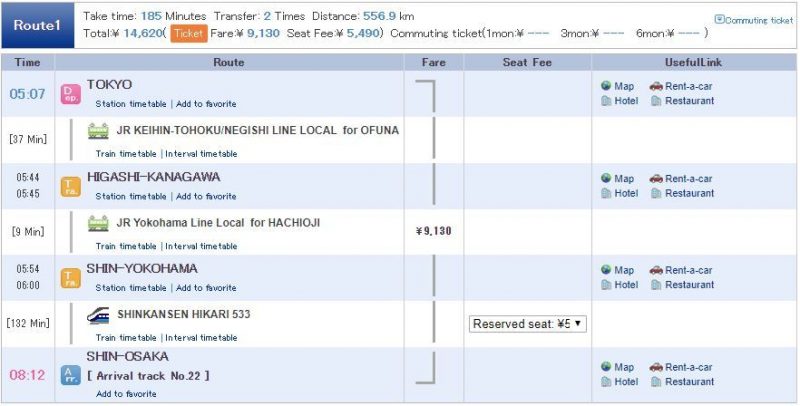
For further tips and advice about understanding search results on this service, including a breakdown of the different symbols used, please check our Hyperdia information page.
Find Shinkansen timetables on Google Maps
Another popular online timetable search option for foreign visitors to Japan, especially among those who have ready access to the internet with a SIM card or pocket WiFi, is to use Google Maps.
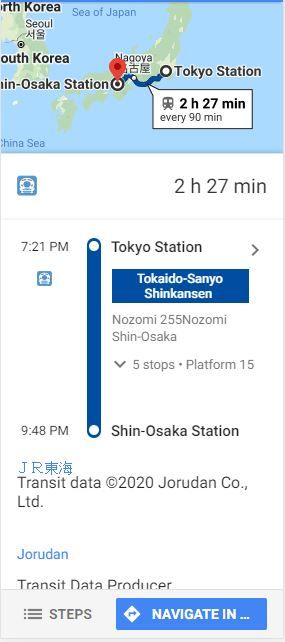
To find Shinkansen bullet train schedules on Google Maps, the traveler is simply required to enter their departure and destination stations, as well as their desired arrival dates and times. The list of available services and travel times will then be displayed.
Consult timetables on JR websites
Apart from using Hyperdia or Google Maps to find their desired Shinkansen route, which are the most efficient and convenient options, travelers are also able to look up and consult full Japanese train timetables online.
Below you’ll find links to the websites of various train operators in Japan, where you can find up-to-date schedule information:
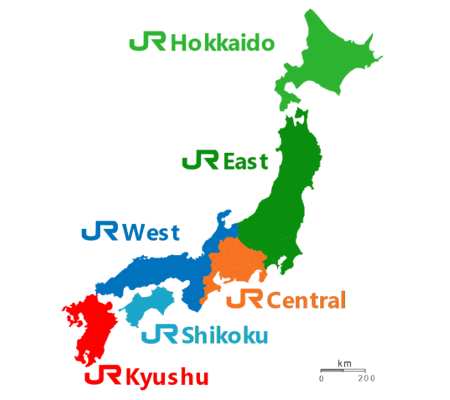
Pick up a printed timetable
Another option for checking Japanese train schedules is to pick up a printed copy of railway timetables, which can be found in many tourist guides for Japan (although it is important to check the information is up-to-date if using this source).
Alternatively, printed train schedules are available in many Japanese train stations and are more likely to be updated with current information.
Foreign visitors often find that many Japanese train timetables are initially quite hard to read and may be in a format that is hard to understand. However, sometimes it is possible to find timetables in Japan that are easier to understand.
Nevertheless, you can see below for a full guide on how to read Japanese timetables.
How to read Shinkansen timetables
An important consideration to take into account when trying to read a Shinkansen train timetable is that there are different schedules depending on the direction of the train, whether from East to West (for example from Tokyo to Osaka), or from West to East (Osaka to Tokyo).
Read more: Traveling between Tokyo and Osaka
There are also different timetables depending on the train service, whether a Hikari, Kodama, or Nozomi train (travel on Nozomi or Mizuho trains is not currently permitted with the JR Pass but will be possible from October 2023 with a supplement).
If you look at the top of any Japanese train timetable, you can see the key where trains which do not operate on sundays and holidays are indicated.
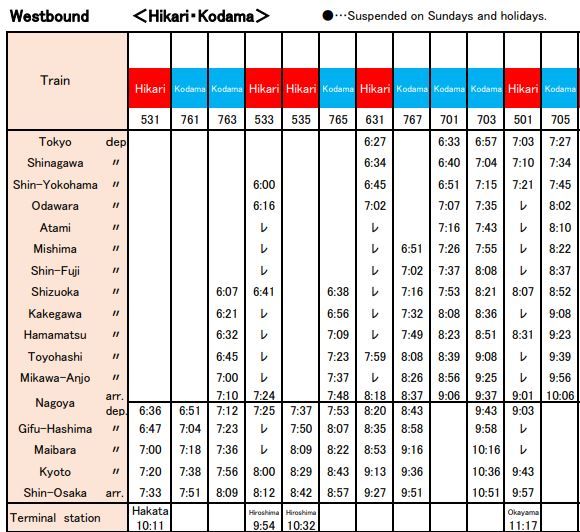
On the left-hand column, you can see the list of different stations included on the route, with the first stops indicated towards the top, and the later stops towards the bottom.
In the columns to the right, ordered by the different trains that operate on each day for this line, you can find the time that the train leaves from each station in descending order. If there is no time indicated for a station, this means this the train does not make a stop there on this service.
Occasionally, the written format of the time may be indicated without a colon separating the hours and minutes.
Sometimes, various types of trains may be included within the same timetable, which can give the appearance of the schedule being impossible to read. However, in these cases, the list of stations is usually included on both the extreme-left and extreme-right columns, making them easier to reference.
For example, this type of timetable can be found in the schedules of JR Central, but it is also the same format used for the eKinet services operated by JR East.
Although it is normally not hard to find Shinkansen timetables in English, some may be presented in both English and Japanese.
